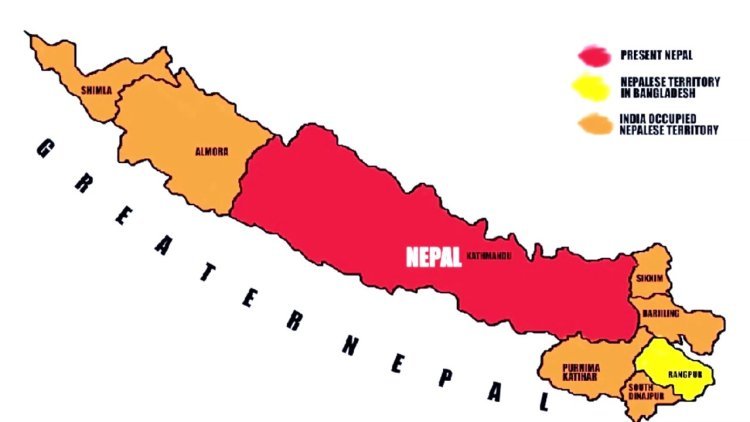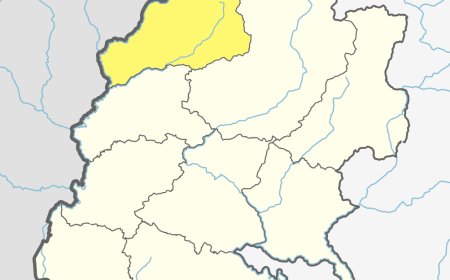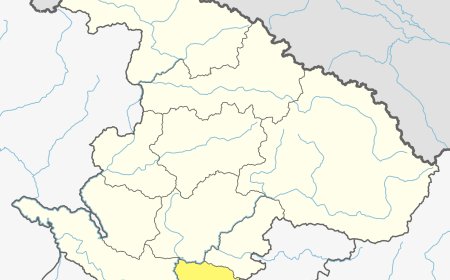Understanding Greater Nepal: History, Legality, and Geopolitical Implications
Uncover the idea of "Greater Nepal" and its significance, from historical roots to modern-day complexities, shedding light on territorial aspirations and geopolitical dynamics.

Greater Nepal, an idea that seeks to extend the boundaries of present-day Nepal to include territories ceded under the Sugauli Treaty, has been a subject of interest, controversy, and nationalistic aspirations. The concept has garnered attention among certain Nepali nationalists who argue for reclaiming what they perceive as lost territory. This article delves into the historical context, nationalist sentiments, contemporary debates, and geopolitical implications surrounding the notion of Greater Nepal.
Historical Background:
The concept of Greater Nepal stems from the historical expansion of the Gorkha Kingdom, led by King Prithvi Narayan Shah, during the late 18th century. The Gorkhas, renowned for their formidable army, embarked on military campaigns and successfully conquered several neighboring states, expanding their influence across the region.
Between 1791 and 1804, the Gorkha army occupied territories that are now part of modern-day India, including areas in Sikkim, West Bengal, Uttarakhand, and Himachal Pradesh. Cities such as Darjeeling, Nainital, Almora, and Dehradun were included in the proposed boundaries of Greater Nepal. These conquests were significant milestones in the history of the Gorkha Kingdom and established a foundation for the idea of a larger Nepali territory.
However, the Gorkha Kingdom's dominance was short-lived. In the Anglo-Nepalese War that ensued between 1814 and 1816, the British East India Company emerged victorious. As a result, the Sugauli Treaty was signed, which forced the Gorkha Kingdom to surrender significant portions of the territory it had acquired during its expansionist phase. The treaty marked the end of Gorkha control over the annexed areas, officially establishing the new border between British India and Nepal.
Nationalist Aspirations and Controversies:
The concept of Greater Nepal gained traction among certain segments of Nepali society due to nationalist aspirations and historical grievances. Proponents of Greater Nepal argue that the territories lost under the Sugauli Treaty should be reclaimed, considering them to be part of Nepal's historical and cultural legacy. They claim that the treaty was unjust and that Nepal was forced to surrender these territories without fair representation or consent.
The notion of Greater Nepal has found support among nationalist political movements, small political parties, and activist organizations. These groups seek to raise awareness about the perceived loss of territory and advocate for the redrawing of borders to incorporate the claimed regions.
Debates and Perspectives:
The idea of Greater Nepal does not enjoy universal support within Nepal. While some politicians and activists support the concept, others dismiss it as unrealistic or impractical. The Maoist leader Prachanda, for instance, has characterized the idea as a "media stunt", underscoring the divergent perspectives on the issue.
Debates surrounding Greater Nepal encompass discussions on historical narratives, national identity, and the potential implications for Nepal's relations with neighboring countries. These debates reflect the complexities and diverse viewpoints within Nepali society, highlighting the ongoing discourse and contestation surrounding the concept of Greater Nepal.
Geopolitical Implications:
The concept of Greater Nepal carries significant geopolitical implications that extend beyond legal and diplomatic considerations. Understanding these implications is crucial for evaluating the potential impact on regional dynamics, security, and the interests of other nations in the area.
-
Regional Stability:
Any territorial claims or attempts to redefine borders can disrupt the delicate balance of power and stability in the region. Redrawing boundaries without consensus and mutual agreement can create tensions and conflicts among neighboring countries, leading to political instability and potential security risks. The pursuit of Greater Nepal must be evaluated in terms of its potential impact on regional stability and the well-being of all countries involved. -
Relations with India:
India, as Nepal's largest and immediate neighbor, plays a pivotal role in Nepal's geopolitical landscape. Any expansionist aspirations may strain bilateral relations, as territorial disputes can intensify nationalist sentiments and lead to strained diplomatic ties. It is essential for Nepal to manage its relationship with India carefully, taking into account mutual interests, historical agreements, and the potential consequences on trade, economic cooperation, and cultural ties. -
Impact on China:
Nepal's pursuit of Greater Nepal may also have implications for its relations with China. China's growing influence in the region and its strategic interests make it an important stakeholder in any territorial disputes. Nepal needs to consider how its actions and aspirations align with its relations with China, ensuring that its pursuit of Greater Nepal does not compromise its overall foreign policy objectives or damage its strategic partnerships. -
Regional Power Dynamics:
Altering the existing territorial boundaries can lead to changes in regional power dynamics. The redefinition of borders may have implications for the distribution of resources, access to trade routes, and control over strategic locations. It is important to evaluate how the concept of Greater Nepal would impact the existing balance of power and the interests of other regional actors. -
Impact on International Community:
The international community closely monitors territorial disputes and any potential threats to regional stability. Nepal's pursuit of Greater Nepal would attract attention from neighboring countries, regional organizations, and global powers. It is essential for Nepal to effectively communicate its intentions, present a strong legal and diplomatic case, and ensure that its actions align with international norms and principles. -
Implications for Nepali Nationalism:
The concept of Greater Nepal resonates with certain segments of Nepali society who hold strong nationalist sentiments. The pursuit of Greater Nepal can mobilize public opinion, shape domestic politics, and influence the country's overall narrative. Understanding the domestic implications and managing nationalist aspirations is crucial for ensuring internal stability and social cohesion.
So, the geopolitical implications of Greater Nepal encompass regional stability, bilateral relations with India, relations with China, regional power dynamics, international perception, and domestic implications. Careful assessment of these implications is vital for Nepal to navigate the complexities of territorial disputes while preserving regional harmony, fostering diplomatic relations, and safeguarding its long-term national interests.
Legal and Diplomatic Considerations:
Addressing the claims of Greater Nepal necessitates careful consideration of legal and diplomatic factors. The legal aspect revolves around the historical context of the Sugauli Treaty and its implications for territorial boundaries. Diplomatic considerations involve managing relationships with neighboring countries, particularly India, and navigating potential conflicts that may arise.
The Sugauli Treaty, signed in 1816 between Nepal and the British East India Company, defined the borders between British India and Nepal. While the treaty was enacted during the colonial era, it remains a legally binding agreement recognized internationally. Any attempt to challenge or revise the treaty would require comprehensive legal analysis, historical evidence, and consensus among all parties involved. It is crucial to respect the legal framework governing border demarcations and international treaties in addressing territorial disputes.
Diplomatically, pursuing the concept of Greater Nepal has implications for Nepal's relations with neighboring countries, particularly India. Given the close geographical proximity and historical ties, maintaining stable diplomatic relations with India is of utmost importance for Nepal's economic and strategic interests. Engaging in dialogue and negotiations with India on matters of territorial claims requires a diplomatic approach that fosters mutual understanding, trust, and respect.
Furthermore, diplomatic considerations extend to other countries as well. China, as another significant neighbor, holds its own geopolitical interests in the region. Nepal must carefully manage its relations with China while ensuring that its pursuit of Greater Nepal does not compromise its overall foreign policy objectives and strategic partnerships.
The pursuit of Greater Nepal must be approached with sensitivity and prudence, considering the potential consequences on regional stability, bilateral relations, and international norms. Engaging in open and constructive dialogue, utilizing diplomatic channels, and exploring peaceful means of resolving disputes can contribute to a more amicable and mutually beneficial resolution.
It is essential to recognize that legal and diplomatic considerations go hand in hand. Respecting international law, adhering to bilateral agreements, and promoting a peaceful and cooperative approach are vital for finding a balanced solution that respects the interests and concerns of all parties involved.
Contemporary Realities and Challenges:
The concept of Greater Nepal faces various contemporary realities and challenges that need to be taken into account when assessing its feasibility and potential implications. These realities and challenges encompass political, legal, demographic, and economic aspects, and understanding them is essential for a comprehensive analysis of the concept.
-
Political Landscape:
Nepal's political landscape has evolved significantly since the signing of the Sugauli Treaty in 1815. The country has transitioned from a monarchy to a federal democratic republic, with a diverse political spectrum and competing interests. The pursuit of Greater Nepal must navigate the complexities of domestic politics, ensuring consensus and support among various political parties and stakeholders. -
Legal Framework:
The existing legal framework, including international treaties, agreements, and historical documents, shapes the territorial boundaries of Nepal. The Sugauli Treaty, ratified in 1816, remains a fundamental legal reference. Any reevaluation or revision of territorial claims would require a robust legal argument, including addressing the validity and applicability of historical agreements and the recognition of existing borders by the international community. -
Demographic Realities:
The demographic composition of the areas encompassed by the concept of Greater Nepal needs to be considered. Over time, populations in these regions have developed distinct identities, cultures, and affiliations with the countries they currently belong to. Redrawing boundaries may raise challenges related to the protection of minority rights, citizenship issues, and the integration of diverse populations into a unified political entity. -
Economic Viability:
The economic viability of a Greater Nepal must be evaluated. Assessing the potential benefits and challenges of incorporating additional territories requires considering factors such as resource allocation, infrastructure development, economic integration, and the overall sustainability of the expanded state. It is essential to analyze whether the economic gains would outweigh the costs and whether the existing resources and capacities of Nepal can effectively accommodate an expanded territory. -
Regional Cooperation:
Greater Nepal would necessitate cooperation and engagement with neighboring countries, particularly India, which shares extensive borders with Nepal. Establishing a constructive dialogue and pursuing collaborative approaches is crucial for addressing concerns, mitigating tensions, and fostering regional stability. Building strong diplomatic ties and engaging in dialogue with neighboring countries will be essential to garner support and address potential challenges. -
International Recognition:
Achieving international recognition for the concept of Greater Nepal poses a significant challenge. Convincing the international community to endorse territorial revisions requires robust legal arguments, diplomatic efforts, and consensus-building. Nepal would need to engage in diplomatic initiatives, presenting its case while addressing concerns raised by other nations and respecting established norms and principles of international law. -
Societal Cohesion:
The pursuit of Greater Nepal may affect societal cohesion within the country. As aspirations and identities are deeply intertwined with territorial claims, managing expectations, fostering inclusivity, and promoting dialogue among different ethnic and cultural groups is vital for maintaining social harmony. Striking a balance between nationalist aspirations and preserving social cohesion will be a significant challenge for Nepal.
In conclusion, The concept of Greater Nepal continues to evoke nationalist sentiments and generate debates within Nepal. While some segments of society advocate for its realization, others view it as impractical or unrealistic. The geopolitical implications, legal considerations, and diplomatic challenges associated with the idea further complicate its feasibility. Ultimately, the status and prospects of Greater Nepal depend on a comprehensive understanding of historical contexts, national aspirations, and the
What's Your Reaction?








































































































